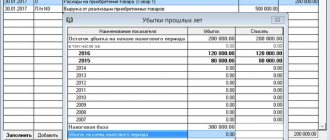Library of the Online School “Become a Chief Accountant”!
10/16/2020
Before using the material, please read important information on this topic.
And also keep in mind the following: - By virtue of clause 4 of Art. 227 of the Tax Code of the Russian Federation, if an individual entrepreneur receives a loss in the current tax period, the individual entrepreneur does not have the right to reduce future income by the amount of this loss. This must be taken into account when choosing a method for accounting for income and expenses. - Based on clause 1 of Art. 273 of the Tax Code of the Russian Federation, the cash method is not applied if, on average, over the previous four quarters, the amount of revenue from the sale of goods (work, services) excluding VAT exceeded 1 million rubles. for each quarter, Resolution of the Sixth Arbitration Court of Appeal dated July 16, 2019. No. 06AP-1695/2019 in case No. A37-828/2017, Resolution of the Sixth Arbitration Court of Appeal dated 06/04/2019 No. 06AP-1873/2019 in case No. A04-3940/2018).
In the cases under consideration, the accrual method is the most applicable.
In the Sample Accounting Policy, we refer to judicial acts or clarifications of authorized bodies in support of each material provision. We also provide as much information as possible on accounting so that you do not have to look for it in regulations. Structure of the accounting policy: 1. General provisions on the organization of accounting, 2.1. Income accounting, 2.2. Cost accounting, 2.3. Forms of primary accounting documents, tax accounting registers, 3. Accounting for fixed assets and intangible assets, 4. Accounting for leasing transactions, 5. Accounting for material costs and goods, 6. Labor costs, 7. VAT, 8. Procedure for conducting cash transactions
Appendix to the Order “On approval of the Accounting Policy for Tax Purposes” dated “_____” 2021 No. 1
An example of an individual entrepreneur's accounting policy for tax purposes (OSNO)
When needed:
when forming accounting policies by an entrepreneur who applies a general taxation system. Using the sample, you can choose the most optimal accounting option from those allowed by tax legislation.
Completed sample
Individual entrepreneur Ivanov A.A.
ORDER No. 5 on approval of accounting policies for tax purposes
1. Approve the accounting policy for tax purposes for 2016 in accordance with the appendix.
2. I entrust control over the execution of this order to myself.
Accounting policies for tax purposes
1. Keep tax records in person.
2. Accounting for property, liabilities and business transactions is carried out separately for each of the following types of activity:
– catering services;
– rental of real estate.
Reason: clause 7 of the Procedure approved by order of August 13, 2002 of the Ministry of Finance of Russia No. 86n and the Ministry of Taxes of Russia No. BG-3-04/430, clause 6 of Article 346.53 of the Tax Code of the Russian Federation.
3. In relation to activities related to the rental of non-residential premises, a patent taxation system is applied.
Reason: subclause 19 of clause 2 of article 346.43 of the Tax Code of the Russian Federation.
4. Entries in the book of income and expenses and business transactions of an individual entrepreneur for activities related to the provision of public catering services are made on the basis of primary documents for each business transaction.
Reason: paragraph 2 of Article 54 of the Tax Code of the Russian Federation, subparagraph 1 of part 2 of Article 6 of the Law of December 6, 2011 No. 402-FZ, paragraphs 4 and 9 of the Procedure approved by order of August 13, 2002 of the Ministry of Finance of Russia No. 86n and the Ministry of Taxes of Russia No. BG-3-04/430.
5. Income from leasing real estate is reflected in the income book of an individual entrepreneur applying the patent taxation system, based on primary documents for each business transaction.
Reason: paragraph 1 of Article 346.53 of the Tax Code of the Russian Federation, subparagraph 1 of part 2 of Article 6 of the Law of December 6, 2011 No. 402-FZ, paragraph 1.1 of the Procedure approved by order of the Ministry of Finance of Russia of October 22, 2012 No. 135n.
Personal income tax
6. Professional tax deduction is recognized in the amount of actually incurred and documented expenses directly related to the extraction of income. The composition of expenses accepted for deduction is determined in the manner prescribed by Chapter 25 of the Tax Code of the Russian Federation.
Reason: Article 221 of the Tax Code of the Russian Federation.
7. Raw materials and materials used in business activities are assessed using the average cost method.
Reason: clause 1 of article 221, clause 8 of article 254 of the Tax Code of the Russian Federation.
8. Purchased goods are valued using the average cost method.
Reason: paragraph 1 of Article 221, subparagraph 3 of paragraph 1 of Article 268 of the Tax Code of the Russian Federation.
9. Transport costs associated with the purchase of goods should be taken into account separately.
Reason: paragraph 1 of article 221, article 320 of the Tax Code of the Russian Federation.
Value added tax
10. Keep separate records of the costs of operations, both subject to VAT and non-taxable (exempt from taxation).
Reason: paragraph 4 of article 149, paragraph 11 of article 346.43 of the Tax Code of the Russian Federation.
11. Tax amounts presented by suppliers for goods (work, services) used in the provision of public catering services, subject to VAT, are accepted for deduction in the manner established by Article 172 of the Tax Code of the Russian Federation, without restrictions.
Reason: paragraph 3 of paragraph 4 of Article 170, Article 172 of the Tax Code of the Russian Federation.
12. Tax amounts presented by suppliers for goods used in the provision of real estate for rent, taxed under the patent system, are not accepted for deduction and are not taken into account when calculating personal income tax.
Reason: subparagraph 3 of paragraph 2, paragraph 4 of Article 170, paragraph 11 of Article 346.43 of the Tax Code of the Russian Federation, letter of the Ministry of Finance of Russia dated July 8, 2005 No. 03-04-11/143.
13. Tax amounts claimed by suppliers for goods used simultaneously in the provision of catering services and in the provision of real estate rental activities are recorded in the purchase ledger during the quarter for the entire amount indicated in the invoice. The amount of deductions is adjusted based on the results of the tax period (quarter).
The adjustment is made in proportion to the revenue from activities taxed under the patent system in the total revenue of the entrepreneur for the quarter. At the same time, the calculation of revenue does not include income recognized as non-operating in accordance with Article 250 of the Tax Code of the Russian Federation. This adjustment is made for each invoice as of the last day of the tax period (quarter).
Amounts of tax subject to restoration at the end of the quarter are not included in the cost of goods (work, services), including fixed assets, and are not taken into account when calculating personal income tax.
Reason: clause 4 of article 149, subclause 2 of clause 3, clauses 4, 4.1 of article 170 of the Tax Code of the Russian Federation, letter of the Ministry of Finance of Russia dated November 22, 2010 No. 03-07-07/74.
Section 1. Accounting for raw materials, semi-finished products and other material costs
3.1.1. Expenses include actually incurred costs associated with generating income from business activities. Material expenses are included in the expenses of the tax period in which the sale of goods, works, and services took place.
3.1.2. When registering the Book of Income and Expenses, Option A of tables 1-1, 1-2, 1-3, 1-4, 1-5, 1-6, 1-7 is filled out, since the individual entrepreneur works with VAT.
Table 1-1 provides data on the types of raw materials purchased and consumed in the production of goods, works or services.
Table 1-2 reflects received and consumed semi-finished products by type of goods, works, and services.
Table 1-3 is used to account for purchased and consumed auxiliary raw materials and supplies.
Table 1-4 is intended to reflect other material costs. These include transportation costs, as well as acquisition costs:
- fuel;
- water;
- various types of energy used for technological needs.
Table 1-5 shows the cost of manufactured finished products, work performed, and services provided.
Tables 1-6, 1-7 reflect the result of production and sales of manufactured products at the time of commission and at the end of the month.
The cost of material expenses in the production of goods, works, and services is written off as expenses only in relation to the goods, works, and services sold.
Type, structure and other aspects of the accounting policy of individual entrepreneurs on OSNO
The accounting policy of individual entrepreneurs on OSNO is formed taking into account the following rules:
- The form of accounting policy (AP) is arbitrary (not regulated by law).
- The content of the UE is all the necessary IP aspects of the accounting and reporting process, as well as organizational and technical nuances.
- Structure - determined by the individual entrepreneur independently (chapters, sections, subsections, appendices, etc.).
- The scope of the management program depends on the level of detail of the information determined by the individual entrepreneur based on the needs of his accounting and reporting process.
- It is not necessary to describe methods and methods of accounting if the individual entrepreneur does not conduct accounting (this opportunity is provided to entrepreneurs subclause 1, clause 2, article 6 of the law on accounting dated December 6, 2011 No. 402-FZ).
- The nuances of tax accounting are provided in the UP without fail (Article 313 of the Tax Code of the Russian Federation), based on the specifics of the activities of the individual entrepreneur and the types of taxes paid by him.
For those who decide not to keep individual entrepreneur accounting on OSNO, when forming their own UE, it is important to be guided by the requirements of Art. 313 of the Tax Code of the Russian Federation, namely:
- after the development of the management program, it must be approved by order (instruction);
- the UP should describe the procedure for accounting for business transactions for tax purposes in such a way that the tax accounting data generated on the basis of such an accounting policy is complete and reliable, allowing one to control the correctness of calculation, completeness and timeliness of calculation and payment of taxes;
- The UP must be applied consistently from year to year.
Accounting for income and expenses
2.1. Income.
Individual entrepreneurs independently calculate personal income tax based on the amount of income received from business activities, reduced by the amount of tax deductions established by Art. 218-221 Tax Code of the Russian Federation. (clause 1, clause 1, clause 2, article 227, clause 1, article 225, clause 3, article 210 of the Tax Code of the Russian Federation).
(Continuation (the main part of the article) You can purchase by clicking on the button below)
If you have any doubts about whether this accounting policy is suitable for you, call us and we’ll discuss it. tel. 8 918 865 0081.
uchetnaya_politika_ip_obrazec.jpg
Related publications
Entrepreneurs may not keep accounting records. They are exempted from this obligation by clause 2 of Art. 6 of the Federal Law of December 6, 2011 No. 402-FZ. Tax accounting for individual entrepreneurs consists of maintaining accounting books - according to the OSN, simplified tax system, and the patent system. However, an accounting policy for individual entrepreneurs is needed to designate methods for calculating the tax base and, if necessary, maintaining accounting and management records.
Is it necessary to draw up an accounting policy?
Currently, no regulatory act directly states that individual entrepreneurs must have an accounting policy. The procedure for determining the tax base is strictly regulated:
in the patent system, one must be guided by the provisions of Chapter. 26.5 of the Tax Code and regional legislation.
But the fact that the document must also be drawn up by entrepreneurs indirectly confirms clause 2 of Art. 11 of the Tax Code - it states that in the accounting policy the taxpayer determines the methods of accounting for income and expenses. And taxpayers also include individual entrepreneurs (in accordance with Article 19 of the Tax Code).
In addition, there are a number of points on which it is necessary to secure the chosen accounting option - to justify the inclusion of costs in the tax base, in order to protect the entrepreneur in the event of a tax audit.
Section VI.
Determination of the tax base 3.4.1. Table 6-1 is filled out based on the results of the calendar year and is used to calculate personal income tax and fill out form 3-NDFL. It takes into account sales income from tables 1-7 and other income (including those received free of charge). Expenses include the results of tables 1-7 (material costs), tables 2-1, 2-2, 3-1, 4-1, 4-2 (depreciation charges), tables 5-1 (labor costs), tables 6-2 (other expenses).
3.4.2. Other expenses (Table 6-2) include expenses related to business activities not included in other sections:
- amounts of paid taxes and fees established by law (except for personal income tax).
- expenses for property protection and fire safety.
- rental (leasing) payments if such property is available.
- travel expenses are within normal limits.
- payment for information, consulting, legal services.
- office, postal, telephone expenses, payment for communication services (including Internet and e-mail).
- expenses for the purchase of computer programs and databases.
- expenses for repairs of fixed assets.
- advertising expenses and other expenses related to business activities.
3.4.3. Table 6-3 indicates the expenses of the current tax period, the income for which will be received in the following tax periods. These may be seasonal expenses.
- Personal income tax (NDFL)
- To calculate the tax base for personal income tax, the accounting data for income and expenses and business transactions reflected in the Book of Income and Expenses are used.
- The tax period is a calendar year (Article 216 of the Tax Code of the Russian Federation).
- Tax rates - in accordance with Art. 224 Tax Code of the Russian Federation.
- The procedure for calculating personal income tax is Art. 225 Tax Code of the Russian Federation.
- The personal income tax return is submitted to the Federal Tax Service at the place of residence of the individual entrepreneur no later than April 30 of the year following the previous year (unless otherwise provided for in Article 227.1 of the Tax Code of the Russian Federation).
Individual entrepreneur___________________
Applications
Composition of the accounting policy of individual entrepreneurs for 2021
What to include in the accounting policy depends not only on the system used, but also on the purposes for which it will be used - for accounting, tax or management accounting. In any case, first of all, the document must reflect:
the accounting forms used are independently developed or unified (for accounting, additionally, the applicable chart of accounts), maintained in electronic form, whether on paper, with or without software.
It is advisable to indicate the person responsible for maintaining records (the individual entrepreneur himself or another official, for example, an accountant).
There is no exact list of issues to be reflected in the accounting policy - an individual entrepreneur can independently outline the range of necessary information that will help to thoroughly understand the methods of calculations.
Accounting policy of individual entrepreneurs on UTII
The example we offer below can be taken as a basis. If an entrepreneur uses only UTII, it is enough for him to indicate in the document how the accounting of taxable objects is kept, and how the paid contributions (at the time of payment) and sick leave benefits are taken into account in the calculation.
If there is a combination of regimes, then in the accounting policies of individual entrepreneurs on UTII and the simplified tax system (or OSNO) it is necessary to explain in detail not only how income and expenses are taken into account, but also how they are distributed among different taxation systems.
Accounting policy of individual entrepreneurs on the simplified tax system
Income accounting
There is no need to fully indicate the formation of the revenue part of the tax base in accordance with the Tax Code. Accounting policy of individual entrepreneur simplified tax system “income”, sample may include:
what is classified as income from main activities and what is classified as other (when separately accounting for different regimes, for example, simplified tax system and UTII, a procedure for their distribution is needed);
other necessary points (for example, the procedure for adjusting the tax base - correcting errors, returning advances and erroneous payments, etc.).
For the accounting policy of individual entrepreneurs on the simplified tax system “income”, which provides for tax accounting, it is enough to additionally write off clauses on the write-off of expenses that reduce the base (the method of their distribution is especially important if there is separate accounting) - contributions, sick leave at the expense of the employer and accounting for sales tax. Since expenses under the simplified tax system of 6% do not affect tax obligations, it makes sense to enter further points into the document only when maintaining full-fledged accounting records.
Therefore, we will further take the individual entrepreneur’s accounting policy “income minus expenses” as a basis.
Fixed Asset Accounting
The accounting policy includes information about the accounting of fixed assets. What they indicate:
which objects are accounted for as inventories, and which are included in fixed assets;
whether the service life of the previous owner is taken into account, or the depreciation rate is determined by the classifier;
the procedure for writing off the cost, including in case of partial payment of property.
Indicate the method of calculating depreciation (linear or non-linear), as well as whether special coefficients or depreciation bonuses are applied.
This section is also important in the accounting policy of individual entrepreneurs on OSNO, since depreciation of fixed assets reduces tax liabilities.
Materials accounting
Describe the procedure for determining the cost of raw materials and materials. Are transportation and procurement costs included in the cost (or are they taken into account separately). How to write off:
at average cost;
at the cost of each unit;
at the cost of the first acquisition in time (FIFO).
You can specify which documents serve as the basis for write-off.
Goods accounting
The document indicates how the cost of goods is formed and whether transport costs are taken into account. How to write off:
at average cost;
by unit cost;
You can describe in detail the methodology for determining the amount of expenses for goods included in the tax base.
In the section you can indicate how other costs are formed (for example, for fuel and lubricants). When accounting separately, it is necessary to describe exactly how the taxpayer distributes expenses (including staff salaries, contributions, sick leave) between different regimes.
Since, with a simplified tax system of 15%, losses from previous years can reduce the tax base, you can prescribe the procedure for their accounting (maintaining a separate register, if there is one). Next, indicate how they are taken into account when obtaining annual profit. The accounting policy of individual entrepreneurs on the simplified tax system, a sample for “income minus expenses,” can be downloaded below.
Section II - IV. Depreciation of fixed assets, equipment and intangible assets
3.2.1. Income from the sale of fixed assets and intangible assets is the difference between the sale and residual value of the property.
3.2.2. Depreciation is expensed in amounts accrued for the tax period. Only the entrepreneur's own property, acquired for payment and used in business activities, is subject to depreciation.
3.2.3. The initial cost of fixed assets consists of the acquisition cost and costs of delivery and commissioning of the property.
3.2.4. Intangible assets include objects of intellectual property acquired or created by an entrepreneur and used in the production of goods, works, and services for more than one year.
Intangible assets include exclusive rights to an invention, trademark, computer program or database, and “know-how”. The initial cost of intangible assets is formed in exactly the same way as fixed assets.
When creating an intangible asset on your own, the initial cost is the cost of its production and registration (obtaining a patent).
3.2.5. To calculate depreciation, tables 3-1, 3-2, 3, 4-1, 4-2 are used.
Accounting policy of individual entrepreneurs on OSNO (filling sample)
Many individual entrepreneurs work fully without even knowing about accounting policies and why they are needed. But every business entity, without exception, must have this document. Accounting policy (AP) is a set of provisions, rules and methods that determine accounting. There are no mandatory forms according to which the accounting policies of individual entrepreneurs are prepared on OSNO. A sample form can be found in the public domain, and you can determine the content yourself.
The legislation clearly defines some aspects of accounting and tax accounting, but there are also points in which variations are allowed. In this article we want to tell you whether an accounting policy is needed for individual entrepreneurs and what exactly it provides. By determining for yourself how and what you will take into account, you thereby simplify the process of organizing and maintaining records, and also create an additional argument in disputes with regulatory services.
Is developing an accounting policy a right or an obligation for an individual entrepreneur?
The answer to this question depends on:
- type of accounting policy (AP);
- structure and features of the activities of individual entrepreneurs;
Most often in practice, the following types of UE are issued:
- for accounting purposes;
- for tax accounting;
- for management accounting.
Get acquainted with the intricacies of management accounting using the materials posted on our website:
- “Accounting policies for management accounting purposes”;
- “We are drawing up a regulation on management accounting (example)”;
- “Management accounting according to IFRS - main advantages”.
At the same time, an individual entrepreneur has the right to develop and apply any types of software - there are no restrictions in the legislation in this regard.
The decision on the need to form a management company is also influenced by the scale of the individual entrepreneur’s activities.
For example, if an entrepreneur’s activities are varied, he strives to effectively organize work and optimize taxation; to resolve these issues, he:
- can implement a budgeting system;
- analyzes the accounting methods used;
- selects the most suitable taxation regimes;
- applies other methods and techniques to improve accounting procedures.
To organize this process, the individual entrepreneur himself is interested in the development and implementation of all three types of accounting policies.
If an entrepreneur provides services of one type, is both a performer and a manager, and does not have employees, then he usually does not need to develop a management program.
However, he will not be able to do without the UP completely due to legal requirements. You will learn from the following sections what legal norms oblige individual entrepreneurs to draw up an accounting policy.
Accounting policy of individual entrepreneurs on OSNO
Entrepreneurs who fill out a book of income and expenses may not keep accounting records. Individual entrepreneurs who choose OSNO can use this opportunity without any problems. Accordingly, in the absence of accounting, accounting policies are also not needed. But you can’t do without drawing up a tax UP. According to the norms of the Tax Code of the Russian Federation, the tax accounting policy must indicate:
- revenue recognition methods;
- methods for recording and recognizing expenses;
- methods for assessing, posting and accounting for other performance indicators used in calculating taxes;
- persons responsible for maintaining records, as well as generating and submitting reports.
The accounting policy of an individual entrepreneur on OSNO must disclose everything related to the taxes calculated and paid by him. The main tax in this case is personal income tax. Entrepreneurs pay it from the difference between income and expenses of their activities. It is necessary to specify in the UE all aspects of their calculation not specified by law, including:
- moment of recognition of certain types of income;
- specifics of depreciation calculation;
- the procedure for accounting for inventory items in the context of recognizing expenses;
- procedure for processing cash transactions and forms of relevant documents, etc.
If an entrepreneur pays VAT, and also, in addition to OSNO, uses other taxation systems (SNO) for certain types of activities (UTII, simplified tax system), then all these points must be specified in the UP, including the distribution of income and expenses among different SNO.
Why is all this IP?
Let me start with the fact that any individual entrepreneur must have an accounting policy. But there is an important point here. The UE can be drawn up for accounting and taxation. So, it is not necessary to compile it for accounting. Why? Because the individual entrepreneur has the right not to maintain it, provided that in accordance with the provisions of the Tax Code of the Russian Federation they fill out the KUDIR. And if an individual entrepreneur uses this right not to conduct accounting, then, of course, there is no need to draw up a management document for this.
On the other hand, there are individual entrepreneurs who do accounting - for example, if the business is quite large, then this is quite justified, since accounting allows you to collect a lot of useful information for yourself. Then an accounting policy for accounting needs to be drawn up.
But everyone should have a tax management system; there is no exception for individual entrepreneurs. According to the Tax Code of the Russian Federation, accounting policy is a set of methods chosen by the taxpayer for determining income/expenses, the procedure for their recognition, assessment, distribution, as well as taking into account other performance indicators that are important in calculating taxes.
The objectives of drawing up accounting policies are:
- Organization of high-quality and reliable recording of indicators;
- Ensuring maximum reliability of tax reporting indicators, reducing the risk of penalties from tax and insurance funds;
- Formation of an information base for analyzing activities and making management decisions.
Any individual entrepreneur keeps records according to the tax payment regime he has chosen. Certain points in the Tax Code of the Russian Federation are spelled out unambiguously, that is, an individual entrepreneur can use one single method of accounting, and in some cases variations are allowed - an individual entrepreneur can choose between several options, the one that suits him best. This is what is reflected in the UP.
We do not indicate methods that are clearly spelled out in it; we already have the right to use only them. But where he can choose, he must choose and indicate it in the document being drawn up. There are also points that are not spelled out in the legislation at all, for example, about how exactly to keep separate records when combining the simplified tax system with imputation. In the previous article, we gave examples of registers that can be used for this and an example of dividing expenses between modes - all this must also be written down in your UE.
Simply put, the UE is a document that reflects how you keep track of income/expenses, which you then use to calculate taxes.
And this document, correctly drawn up and approved in a timely manner, can greatly help you in the future, for example, during tax audits. If there is no established calculation procedure by law, you, quite logically, use the one that is beneficial to you. But if it is not fixed in your accounting policy, then tax authorities have every right to calculate the indicators in their own way - and then charge additional taxes and penalties. If, when combining regimes, you divide expenses in some table, but did not attach its form to the UP, then the tax office may again not accept these amounts as expenses that reduce the tax base. And so on.
Of course, many will now say that no one needs this at all, no one has ever checked this, etc. I will give only two arguments:
- The fact that no one has ever checked your UE for taxation does not mean that it does not need to be drawn up - it must be drawn up;
- It’s not the tax office that needs this, it’s you, first of all, who needs it - especially if the business is quite large, if expansion is planned, if there are many employees, if you pay significant amounts of tax - this is the basis for control over the entire business and a protective barrier from inspectors.
Accounting policy of individual entrepreneurs on the simplified tax system, PSN and UTII
Entrepreneurs who have chosen the simplified tax system, regardless of its type, must also draw up a tax accounting policy. Individual entrepreneurs using the simplified 6% system only write down in it what concerns income accounting. Individual entrepreneurs using the simplified tax system, taking into account both expenses and income, draw up accounting policies in almost the same way as entrepreneurs using the OSNO (taking into account the difference between the simplified tax system and personal income tax). The first point of this document in both cases will be an indication of which particular object of taxation is used - only income or income and expenses.
As for entrepreneurs on UTII, it is important for them to indicate in the UP the applicable tax calculation formulas down to the smallest detail. When combining UTII with any other taxation system, it is necessary to clearly describe how income and expenses will be distributed between types of activities falling under different SNOs. It may also contain forms of primary documents used in the process of processing various business transactions.
UE for small and micro businesses
Before drawing up the UE, it is important to decide whether the individual entrepreneur is a small business or a micro-enterprise. Simplified methods of accounting are provided for them, which need to be reflected in the UE.
| Individual entrepreneur category | Revenue excluding VAT for the year | Average headcount |
| Small business | 800 million rubles | 100 people or less |
| Microenterprise | 120 million rubles | 15 people or less |
For example, an individual entrepreneur can select and indicate the following simplifications in the UE:
- cash method instead of accrual method;
- do not use a number of PBUs;
- prepare reports in a reduced volume;
- use simplified reporting forms;
- refuse to revaluate fixed assets and intangible assets;
- refuse to use accounting entries (for micro-enterprises);
- other simplifications provided for by the Ministry of Finance of the Russian Federation.
Individual entrepreneurs do not have to completely switch to simplified methods. The UP must indicate which of them he will apply and which he will leave as standard.
An example of an individual entrepreneur's accounting policy on OSNO
You can compose the UE in any form. There are also no special requirements for content. As a rule, the following information is indicated:
- the person who maintains tax records;
- the taxation system used;
- What means are used to record income and expenses (books, magazines, special accounting programs, etc.);
- basis for making entries;
- specifics of depreciation calculation;
- features of accounting for inventory, expenses and losses;
- when combining types of activities, the procedure for dividing income and expenses is indicated;
- procedure for calculating expenses for personal income tax;
- specifics of VAT calculation (if the individual entrepreneur is a payer).
To summarize the above, we can say that accounting policies are an important organizational document in any business. Its preparation saves the entrepreneur from having to choose a method for accounting for certain controversial issues each time. In addition, consistent use of the same accounting methods makes the results more transparent and objective. And employees of the Federal Tax Service will not be able to recalculate taxes in their favor if the UE is drawn up correctly and in strict accordance with current legislation.
What does the UP contain?
It reflects the following main points:
- Organization of accounting - who keeps it (a staff accountant, yourself or an employee of a company specializing in such services), how it is kept (manually or automatically, based on which registers or in which specialized accounting program), etc.;
- Accounting methodology – the main provisions of accounting, how accounting is carried out, how certain final indicators are calculated, etc.;
- Document flow diagram, procedure for drawing up primary documents, their forms;
- Forms of registers used;
- Procedure for filling out a tax return.





